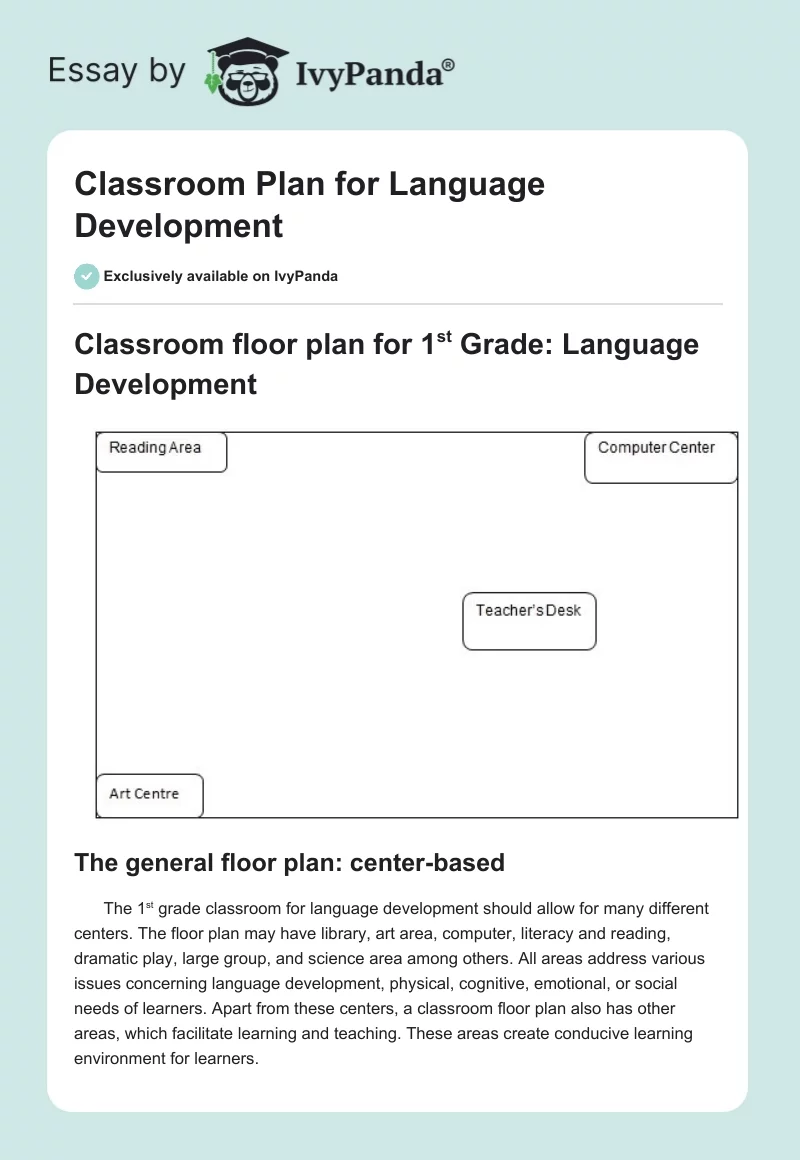Classroom floor plan for 1st Grade: Language Development
The 1st-grade classroom for language development should allow for many different centers. The floor plan may have library, art area, computer, literacy and reading, dramatic play, large group, and science area among others. All areas address various issues concerning language development, physical, cognitive, emotional, or social needs of learners.
Apart from these centers, a classroom floor plan also has other areas, which facilitate learning and teaching. These areas create conducive learning environment for learners. This paper addresses only three areas (in the above floor plan) in a classroom floor plan that can facilitate language acquisition in 1st-grade classrooms.

Reading Area
There are many literacy materials in this area. They include books, letter charts, papers, and site words. There are also listening materials in the reading area for book tapes or music to facilitate reading, listening, and literacy.
The area provides several opportunities for group reading, discussions, writing, and collaboration with other learners so that learners can develop abilities to read and understand written materials. In all, the area must facilitate the acquisition of language skills like “reading comprehension, language, social, and writing skills” (Morrow, 2003).
The teacher introduces various books to learners. Learners can choose interesting books for reading purposes. The teacher then reads the book as children listen. He may then ask the children what they can remember from the book. At this stage, the teacher only provides minimal support to the children so that they can understand the text on their own. Children must take turn in reading the book as the teacher guides them.
Learners must read loudly for the whole class to hear. The teacher must also provide opportunities for learners to recap the book. The teacher may introduce verbal skills by asking questions as learners respond. He may also help learners to learn new words and develop their vocabulary skills by defining such words.
Teachers can assess the effectiveness of reading areas by observing reading, comprehension, writing, interaction, and vocabulary usages among learners. Positive results could indicate that the reading center has enhanced language development among learners.
Art Center
Art center has paints, crayons, papers, markers, and other materials for art works. Children have tendencies to express their ideas through drawings and pictures, and use different colors to show different emotions. They also develop motor skills by cutting and fixing materials. At the same time, learners develop their cognitive skills by expressing their ideas on papers or drawing boards. Language development takes place in cases where learns can verbalize various forms of arts.
Teachers can recognize how learners develop their language skills through various actions. For instance, a learner begins to request for art materials in order to create his or her object. They may also call for help from the teacher or other learners. The teacher’s role is to ask if any learner needs help. Consequently, learners will have to request for the teacher’s help in cases of difficulties.
Learners must actively engage in expressing their ideas through drawings and words. The teacher can request a learner to explain the content of the art he or she has created.
The teacher can assess the discussion and verbalization skills among learners in order to understand the effectiveness of the art center in language development.
Technology Center
Technology center for language development should encourage collaboration, learners’ motivation, and encouraging reading and listening. Computers have several programs to help learners acquire language skills. Learners can develop fine motor skills through typing processes. Computers also have games, which can broaden their thinking abilities. At the same time, new terminologies used in computers can help in developing learners’ vocabulary.
Learners have passions for playing computer games. These games are useful in developing language skills. In addition, there are also programs, which teach language skills on computers. Software developers have linked fun and language development skills for learners. The main role of the teacher is to instruct learners and watch them as they read and listen.
Learners can also read e-books. There are also audio versions, which learners can listen to as they follow written words of the text on the screen. This helps learners to develop advanced reading and listening skills. Children have deep interests in machines and technologies. The strategy may develop learners’ interests and help reluctant learners practice new methods of reading. Teachers can assess listening abilities, reading skills, vocabulary usages, and interests in computer-aided classes.
The ideal classroom for language development must have various centers and facilities to encourage the acquisition of social, language, cognitive, reading, and other skills related to learning. Such a floor plan also accommodates needs of other learners. Therefore, such centers have abilities to meet language acquisition needs among learners.
Teachers who understand how learners acquire languages are able to promote effective language development. Provisions of effective learning environments and appropriate materials can ensure that learners acquire new skills in language development (Piper, 2012).
References
Morrow, L. (2003). Organizing and managing the language arts block: A professional development guide. New York, NY: Guilford Press.
Piper, T. (2012). Making Meaning, Making Sense: Children’s Early Language Learning. San Diego: Bridgepoint Education.


